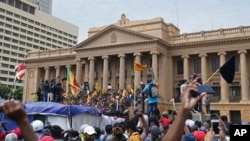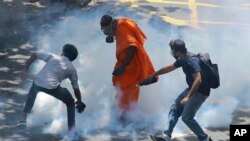The fallout from the protests in Sri Lanka’s capital that has resulted in the upcoming resignations of President Gotabaya Rajapaksa and Prime Minister Ranil Wickremesinghe continues.
Monday, the prime minister said all Cabinet ministers will step down once an interim government has been formed.
Sri Lanka’s opposition parties met Sunday to discuss forming a new government. The meeting came a day after the president and the prime minister said they would step down.
Sri Lankan protesters Sunday said they would continue to occupy the official residences of the president and prime minister in Colombo until they officially leave office.
Thousands of protesters stormed both residences on Saturday. They ransacked President Gotabaya Rajapaksa’s home and set fire to Prime Minister Ranil Wickremesinghe’s residence amid mounting public outrage over a monthslong economic crisis.
Rajapaksa and the prime minister have agreed to resign with the president telling the parliament speaker, he would step down July 13 to ensure a smooth transition of power.
However, the protesters demand that the resignations take effect immediately.
President Rajapaksa was taken by troops to a safe, undisclosed location ahead of the massive protest. Widely blamed for the devastating economic downturn, he has been under public pressure to quit for months.
The president’s decision to resign was announced after Prime Minister Wickremesinghe also offered to step down and make way for an all-party government.
The political crisis unraveled as Colombo witnessed widespread public fury after thousands converged in the city for the biggest anti-government protest seen in recent months.
Dramatic footage on social media showed hundreds of people swarming President Rajapaksa’s palatial residence, chanting slogans, packing corridors and sitting in rooms while some are seen taking a dip in a swimming pool. Jubilant protesters also entered the president’s office shouting “You thought you could stop us, but here we are.”
Authorities had deployed nearly 20,000 troops ahead of the rally and reinforced security outside the president’s residence, but they could not hold back defiant protesters from breaking through security barricades.
They had come in buses, trains and trucks, waving black and national flags and chanting “Gota, go home” — the cry that has been ringing in Colombo for three months demanding that President Gotabaya Rajapaksa quit.
Dozens of people were injured as chaotic scenes unfolded throughout the day.
Police initially imposed a curfew Friday to prevent the rally, but it was lifted after strong objections by civil society groups and opposition parties.
India dismissed reports Sunday that that it had sent troops to Sri Lanka to help with crowd control. The Indian High Commission said in a statement that it “would like to categorically deny speculative reports in sections of media and social media about India sending her troops to Sri Lanka.”
In Bangkok, U.S. Secretary of State Antony Blinken said Sunday the United States is monitoring the developments in Sri Lanka.
“We would urge the Sri Lankan parliament to approach this with a commitment to the betterment of the country, not any one political party. And then it’s incumbent on the government, whether it’s a new constitutionally selected government, the existing government, to work quickly, to try to identify and implement solutions that will bring back the prospect of long-term economic stability to address the Sri Lankan people’s discontent,” he said.
Frustration has been building in Sri Lanka over the worsening fuel shortages and runaway inflation that has led to a massive hike in food prices. Much of the public ire is directed against President Rajapaksa and other members of his family who had held powerful posts in the government. While others had resigned, the president had so far defied calls to quit.
Wickremesinghe, who became prime minister in May after former Prime Minister Mahinda Rajapaksa quit, faces anger because he is seen as being close to the Rajapaksas and was accused of trying to protect them.
Protesters also stormed the prime minister’s private residence in an affluent neighborhood at night and set it on fire. He had also been moved to a safe location as the protests escalated, according to reports.
The Rajapaksas, a powerful political dynasty, who returned to power in 2019, are blamed for policies that have virtually bankrupted the island nation of 22 million.
In recent weeks, the country has come to a virtual standstill as it cannot import food, fuel, or medicines because of its depleted foreign exchange reserves — schools have been shut for three weeks, government employees have been asked to work from home and factories find it difficult to operate thanks to power outages and fuel shortages.
Sales of gasoline and diesel for private vehicles were banned Sunday for two weeks after authorities said the country was left with less than a day’s worth of fuel stocks for regular demand. Soaring inflation has made food expensive.
While the crisis was years in the making, mismanagement during President Rajapaksa’s tenure compounded the problems, according to economists. Populist tax breaks depleted government revenues, an abrupt switch to organic farming led to a steep fall in agricultural production even as the pandemic battered its tourist dependent economy. Massive loans to finance infrastructure projects built by China added to its debt burden.
The country is negotiating with the International Monetary Fund for a bailout, but the political instability that now wracks the country could undermine the process.
Some information in this report came from The Associated Press.









